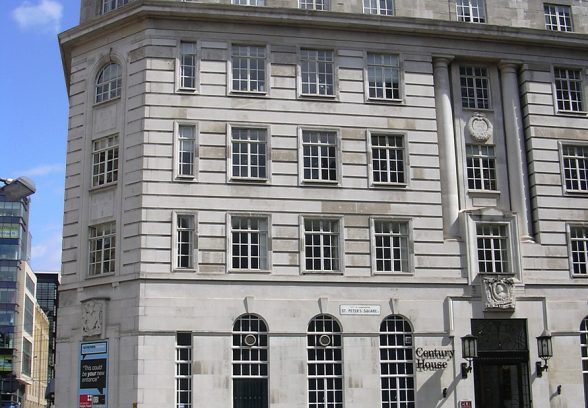This website uses cookies
This website uses cookies to enable it to function properly and to analyse how the website is used. Please click 'Close' to accept and continue using the website.



The Twentieth Century Society has strongly objected to an application to demolish Century House, a prominent inter-war building in St. Peter’s Square, Manchester.
Century House is a well detailed, neo-classical Portland stone office building built in 1934 to a design by A W Roques FRIBA, a noted contemporary architect and was one of a series of buildings he designed for the Friends Provident Society. Roques worked in close collaboration with key architects of the time such as Giles Gilbert Scott, with whom he designed the friends Provident offices in Bristol. The materials and detailing of Century House in particular reflect the contemporaneous Vincent Harris’s Grade II* listed Town Hall Extension and Central Library, which are also located in St. Peter’s Square. This deliberate relationship is evidenced by the work of the same sculptor, Joseph Hermon Cawthra, on both Century House and the Town Hall Extension.
The application (which was lodged with Manchester City Council in May 2013) entails the demolition of Century House and several adjacent buildings, which not only completes an ensemble of buildings in St. Peter’s Square, but also contribute to views from the other adjacent conservation areas. Century House is located in the George Street Conservation Area, to which English Heritage consider it to make “a positive contribution”, but is also on the boundary of both St Peter’s and Albert Square conservation areas. The loss of this substantial anchor building will alter the character of both St Peter’s and Albert Squares, irreversibly degrading them. The Society believes that the proposed demolition and replacement development will cause substantial harm to all three conservation areas.
Century House was assessed for listing by English Heritage in November 2012. They considered it to be “a prominent building, which is of strong local interest” and praised it as being “well-designed.” (English Heritage Assessment Report – No. 475783 28 November 2012). Despite these conclusions English Heritage determined that it fell short of the criteria for listing largely due to internal alterations.
The current scheme proposes replacing the existing buildings with a single twelve-storey office building with retail use at ground floor level and basement car parking, designed by Ian Simpson Architects. The Society has criticised the proposed replacement building as overpowering. It fails to reference the key architecture in the vicinity in either style, size or materials. Rather than blending with the Town Hall Extension and Library, the new development will draw the eye away from this important civic ensemble opposite Century House. This will also damage the diversity of the conservation areas which relate to the site, destroying the variety of building height and scales which lend interest to the locality.
The Society considers Century House to be of significance for its architectural solidity and styling, its group value with the contemporaneous listed buildings of St. Peter’s Square and its contribution to the streetscape in this high profile Manchester location. The loss of this building to be replaced by an overbearing and architecturally undistinguished replacement will cause irreversible damage to the conservation area. This application is another in a series affecting St Peter’s Square, including the Library Walk link, which the Society believes will ultimately devalue the conservation area status of St Peter’s Square.
Currently pending determination, a decision is expected on the future of Century House in July.
Clare Price

Become a C20 member today and help save our modern design heritage.